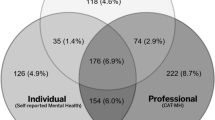Abstract
A study was conducted to assess the belief systems of the general public concerning the appropriate treatments for mental disorders and correlates of these belief systems. The study was based on the results of a household survey of the general public in Australia, using a national random sample of 2,031 adults aged 18–74 years. Respondents were given a vignette describing either a person with depression or one with schizophrenia, and were asked for their opinions about the helpfulness of various professional and non-professional treatments for the person described. A principal components analysis of the helpfulness ratings gave three factors: a Medical factor with high loadings on all drug treatments (exceptVitamins) and onPsychiatric ward andECT; a Psychological factor with high loadings onCounsellor, Social worker, Phone counselling, Psychiatrist, Psychologist, Psychotherapy andHypnosis; and a Lifestyle factor with high loadings onClose family, Close friends, Naturopath, Vitamins, Physical activity andGet out more. The same factors emerged from ratings of the two vignettes. Mean scores on scales constructed from the items with high loadings showed that the public tend to have a negative view of medical treatments and a positive view of psychological and lifestyle ones. However, medical treatments were rated more negatively for depression than for schizophrenia, psychological treatments were rated more positively for schizophrenia, and lifestyle treatments more positively for depression. Age, sex and education of respondents showed few associations with scores on the scales, although the better educated were more in favour of psychological treatments for both depression and schizophrenia and were less opposed to medical treatments for schizophrenia. Respondents who had suffered from the symptoms described in the schizophrenia vignette were more negative towards medical treatments. These findings about public belief systems could have implications for the provision of treatment: where there is a discrepancy in belief system between the patient and the clinician there may be poor adherence to treatment.
Similar content being viewed by others
References
American Psychiatric Association (1994) Diagnostic and statistical manual of mental disorders, 4th edn. DSM-IV. American Psychiatric Association. Washington, D.C.
Angermeyer MC, Däumer R, Matschinger H (1993) Benefits and risks of psychotropic medication in the eyes of the general public: results of a survey in the Federal Republic of Germany. Pharmacopsychiatry 26:114–120
Byrne A, Byrne DG (1993) The effect of exercise on depression, anxiety and other mood states: a review. J Psychosom Res 37:565–574
Greenacre MJ (1984) Theory and applications of correspondence analysis. Academic Press, London
Henderson S, Byrne DG, Duncan-Jones P (1981) Neurosis and the social environment. Academic Press, Sydney
Jorm AF (1994) Characteristics of Australians who consulted a psychologist for a health problem: an analysis of data from the 1989–90 National Health Survey. Aust Psychol 29:212–215
Jorm AF, Rosenman SJ, Jacomb PA (1993) Inequalities in the regional distribution of private psychiatric services provided under Medicare. Aust N Z J Psychiatry 27:630–637
Jorm AF, Korten AE, Jacomb PA, Christensen H, Rodgers B, Pollitt P (1997a) “Mental health literacy”: a survey of the public's ability to recognise mental disorders and beliefs about treatment. Med J Aust 166:182–186
Jorm AF, Korten AE, Jacomb PA, Christensen H, Rodgers B, Pollitt P (1997b) Public beliefs about causes and risk factors for depression and schizophrenia. Soc Psychiatry Psychiatr Epidemiol 32:143–148
McKeon P, Carrick S (1991) Public attitudes to depression: a national survey. Irish J Psychol Med 8:116–121
Regier DA, Hirschfeld RMA, Goodwin FK, Burke JD, Lazar JB, Judd LL (1988) The NIMH depression awareness, recognition, and treatment program: structure, aims, and scientific basis. Am J Psychiatry 145:1351–1357
Sims A (1993) The scar that is more than skin deep: the stigma of depression. Br J Gen Pract 43:30–31
World Health Organization (1993) The ICD-10 classification of mental and behavioural disorders. World Health Organization, Geneva
Author information
Authors and Affiliations
Rights and permissions
About this article
Cite this article
Jorm, A.F., Korten, A.E., Rodgers, B. et al. Belief systems of the general public concerning the appropriate treatments for mental disorders. Soc Psychiatry Psychiatr Epidemiol 32, 468–473 (1997). https://doi.org/10.1007/BF00789141
Accepted:
Issue Date:
DOI: https://doi.org/10.1007/BF00789141




